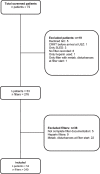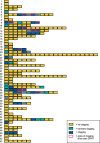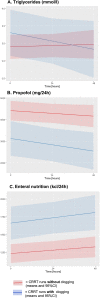Metabolic disturbances potentially attributable to clogging during continuous renal replacement therapy
- PMID: 38127207
- PMCID: PMC10739685
- DOI: 10.1186/s40635-023-00581-9
Metabolic disturbances potentially attributable to clogging during continuous renal replacement therapy
Abstract
Background: Clogging is characterized by a progressive impairment of transmembrane patency in renal replacement devices and occurs due to obstruction of pores by unknown molecules. If citrate-based anti-coagulation is used, clogging can manifest as a metabolic alkalosis accompanied by hypernatremia and hypercalcemia, primarily a consequence of Na3Citrate infusion. An increased incidence of clogging has been observed during the COVID-19 pandemic. However, precise factors contributing to the formation remain uncertain. This investigation aimed to analyze its incidence and assessed time-varying trajectories of associated factors in critically ill patients on continuous renal replacement therapy (CRRT).
Methods: In this retrospective, single-center data analysis, we evaluated COVID-19 patients undergoing CRRT and admitted to critical care between March 2020 and December 2021. We assessed the proportional incidence of clogging surrogates in the overall population and subgroups based on the specific CRRT devices employed at our institution, including multiFiltrate (Fresenius Medical Care) and Prismaflex System (Baxter). Moderate and severe clogging were defined as Na > 145 or ≥ 150 mmol/l and HCO3- > 28.0 or ≥ 30 mmol/l, respectively, with a total albumin-corrected calcium > 2.54 mmol/l. A mixed effect model was introduced to investigate factors associated with development of clogging.
Results: Fifty-three patients with 240 CRRT runs were analyzed. Moderate and severe clogging occurred in 15% (8/53) and 19% (10/53) of patients, respectively. Twenty-seven percent (37/136) of CRRTs conducted with a multiFiltrate device met the criteria for clogging, whereas no clogging could be observed in patients dialyzed with the Prismaflex System. Occurrence of clogging was associated with elevated triglyceride plasma levels at filter start (p = 0.013), amount of enteral nutrition (p = 0.002) and an increasing white blood cell count over time (p = 0.002).
Conclusions: Clogging seems to be a frequently observed phenomenon in critically ill COVID-19 patients. The presence of hypertriglyceridemia, combined with systemic inflammation, may facilitate the development of an impermeable secondary membrane within filters, thereby contributing to compromised membrane patency.
Keywords: COVID-19; CRRT; Dialysis; Hypertriglyceridemia; ICU.
© 2023. The Author(s).
Conflict of interest statement
None of the authors have financial nor non-financial competing interest in association with this study.SD is part of the editorial board of Intensive Care Medicine Experimental.
Figures







Similar articles
-
Efficacy and complications of regional citrate anticoagulation during continuous renal replacement therapy in critically ill patients with COVID-19.J Crit Care. 2022 Feb;67:126-131. doi: 10.1016/j.jcrc.2021.10.010. Epub 2021 Nov 9. J Crit Care. 2022. PMID: 34768173 Free PMC article.
-
Regional citrate anticoagulation for PrismaFlex continuous renal replacement therapy.Ann Pharmacother. 2009 Sep;43(9):1419-25. doi: 10.1345/aph.1M182. Epub 2009 Aug 18. Ann Pharmacother. 2009. PMID: 19690224
-
[Safety and efficacy of regional citrate anticoagulation in continuous renal replacement therapy in the presence of acute kidney injury after hepatectomy].Zhonghua Wei Zhong Bing Ji Jiu Yi Xue. 2018 Aug;30(8):777-782. doi: 10.3760/cma.j.issn.2095-4352.2018.08.013. Zhonghua Wei Zhong Bing Ji Jiu Yi Xue. 2018. PMID: 30220281 Chinese.
-
Complications associated with continuous renal replacement therapy.Semin Dial. 2021 Nov;34(6):489-494. doi: 10.1111/sdi.12970. Epub 2021 Apr 7. Semin Dial. 2021. PMID: 33827146 Review.
-
Citrate Anticoagulation during Continuous Renal Replacement Therapy.Contrib Nephrol. 2017;190:19-30. doi: 10.1159/000468833. Epub 2017 May 23. Contrib Nephrol. 2017. PMID: 28535516 Review.
Cited by
-
Coagulation Risk Predicting in Anticoagulant-Free Continuous Renal Replacement Therapy.Blood Purif. 2024;53(11-12):916-927. doi: 10.1159/000540695. Epub 2024 Aug 12. Blood Purif. 2024. PMID: 39134011 Free PMC article.
References
-
- Nadim MK, Forni LG, Mehta RL, Connor MJ, Jr, Liu KD, Ostermann M, Rimmele T, Zarbock A, Bell S, Bihorac A, Cantaluppi V, Hoste E, Husain-Syed F, Germain MJ, Goldstein SL, Gupta S, Joannidis M, Kashani K, Koyner JL, Legrand M, Lumlertgul N, Mohan S, Pannu N, Peng Z, Perez-Fernandez XL, Pickkers P, Prowle J, Reis T, Srisawat N, Tolwani A, Vijayan A, Villa G, Yang L, Ronco C, Kellum JA. COVID-19-associated acute kidney injury: consensus report of the 25th Acute Disease Quality Initiative (ADQI) Workgroup. Nat Rev Nephrol. 2020;16:747–764. doi: 10.1038/s41581-020-00356-5. - DOI - PMC - PubMed
-
- Sabaghian T, Kharazmi AB, Ansari A, Omidi F, Kazemi SN, Hajikhani B, Vaziri-Harami R, Tajbakhsh A, Omidi S, Haddadi S, Shahidi Bonjar AH, Nasiri MJ, Mirsaeidi M. COVID-19 and acute kidney injury: a systematic review. Front Med (Lausanne) 2022;9:705908. doi: 10.3389/fmed.2022.705908. - DOI - PMC - PubMed
-
- Li R, Gao X, Zhou T, Li Y, Wang J, Zhang P (2022) Regional citrate versus heparin anticoagulation for continuous renal replacement therapy in critically ill patients: a meta-analysis of randomized controlled trials. Ther Apher Dial. - PubMed
-
- KDIGO (2012) Kidney Disease improving Glonal outcomes—clinical practice guideline for acute kidney injury. KI Supplements 2
LinkOut - more resources
Full Text Sources
Miscellaneous

